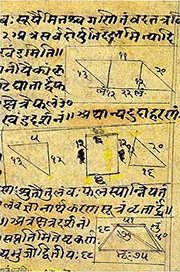Shashthamsha, Ṣaṣṭhāṃśa, Shashtha-amsha: 9 definitions
Introduction:
Shashthamsha means something in Hinduism, Sanskrit, Hindi. If you want to know the exact meaning, history, etymology or English translation of this term then check out the descriptions on this page. Add your comment or reference to a book if you want to contribute to this summary article.
The Sanskrit term Ṣaṣṭhāṃśa can be transliterated into English as Sasthamsa or Shashthamsha, using the IAST transliteration scheme (?).
Alternative spellings of this word include Shashthansh.
In Hinduism
Jyotisha (astronomy and astrology)
Source: Wisdom Library: Brihat Samhita by VarahamihiraṢaṣṭhāṃśa (षष्ठांश) refers to the “sixth section of the firmament”, according to the Bṛhatsaṃhitā (chapter 5), an encyclopedic Sanskrit work written by Varāhamihira mainly focusing on the science of ancient Indian astronomy astronomy (Jyotiṣa).—Accordingly, “If the sun and moon should begin to be eclipsed when only half risen, deceitful men will suffer as well as sacrificial rites. [...] If when in mid-heaven, the central provinces will suffer, but there will be happiness over the land and the price of food grains will fall. If when in the fifth section, herbivorous animals, ministers and household inmates will suffer as also the Vaiśyas. If they should be eclipsed when in the sixth section of the firmament [i.e., ṣaṣṭhāṃśa —ṣaṣṭhe'ṃśe], women and the Śūdras will suffer; if when setting, robbers and the border Mlecchas will perish. Those will be happy in whose section the eclipse terminates”.

Jyotisha (ज्योतिष, jyotiṣa or jyotish) refers to ‘astronomy’ or “Vedic astrology” and represents the fifth of the six Vedangas (additional sciences to be studied along with the Vedas). Jyotisha concerns itself with the study and prediction of the movements of celestial bodies, in order to calculate the auspicious time for rituals and ceremonies.
Ganitashastra (Mathematics and Algebra)
Source: archive.org: Hindu MathematicsṢaṣṭhāṃśa (षष्ठांश) or Ṣaṣṭhabhāga refers to the “sixth part” (i.e., one-sixth) in Bhinna (“fractions”) and Bhāga (“unit fractions”), which refers to one of the twenty operations (logistics) of pāṭīgaṇita (“science of calculation which requires the use of writing material—the board”), according to Pṛthudakasvāmī’s commentary on the Brāhmasphuṭasiddhānta by Brahmagupta, a Sanskrit treatise on ancient Indian mathematics (gaṇita-śāstra) and astronomy from the 7th century.—In the Śulba, unit fractions are denoted by the use of a cardinal number with the term bhāga or aṃśa; [...]. The use of ordinal numbers with the term bhāga or aṃśa is also quite common, e.g., pañcama-bhāga (“fifth part”) is equivalent to one-fifth, and so on [e.g., ṣaṣṭhāṃśa].

Ganitashastra (शिल्पशास्त्र, gaṇitaśāstra) refers to the ancient Indian science of mathematics, algebra, number theory, arithmetic, etc. Closely allied with astronomy, both were commonly taught and studied in universities, even since the 1st millennium BCE. Ganita-shastra also includes ritualistic math-books such as the Shulba-sutras.
Languages of India and abroad
Sanskrit dictionary
Source: DDSA: The practical Sanskrit-English dictionaryṢaṣṭhāṃśa (षष्ठांश).—
1) a sixth part in general.
2) particularly, the sixth part of the produce of fields &c., which the king takes from his subjects as land-tax; ऊधस्यमिच्छामि तवोप- भोक्तुं षष्ठांशमुर्व्या इव रक्षितायाः (ūdhasyamicchāmi tavopa- bhoktuṃ ṣaṣṭhāṃśamurvyā iva rakṣitāyāḥ) R.2.66; (the different kinds of produce, to the sixth part of which a king is entitled, are specified in Manusmṛti 7.131-132). °वृत्तिः (vṛttiḥ) a king (entitled to the sixth part of the produce); षष्ठांशवृत्तेरपि धर्म एषः (ṣaṣṭhāṃśavṛtterapi dharma eṣaḥ) Ś.5.4.
Derivable forms: ṣaṣṭhāṃśaḥ (षष्ठांशः).
Ṣaṣṭhāṃśa is a Sanskrit compound consisting of the terms ṣaṣṭha and aṃśa (अंश).
Source: Cologne Digital Sanskrit Dictionaries: Shabda-Sagara Sanskrit-English DictionaryṢaṣṭhāṃśa (षष्ठांश).—m.
(-śaḥ) 1. The sixth part of agricultural produce taken by the sovereign from the subject in the shape of a land-tax. 2. A sixth part in general.
Source: Cologne Digital Sanskrit Dictionaries: Cappeller Sanskrit-English DictionaryṢaṣṭhāṃśa (षष्ठांश).—[masculine] = ṣaḍbhāga.
Source: Cologne Digital Sanskrit Dictionaries: Monier-Williams Sanskrit-English DictionaryṢaṣṭhāṃśa (षष्ठांश):—[from ṣaṣṭha > ṣaṣ] m. a sixth part, ([especially]) the amount of tax or of grain etc. taken in kind by a king (cf. ṣaḍ-bhāga), [Yājñavalkya; Raghuvaṃśa; Mārkaṇḍeya-purāṇa]
[Sanskrit to German]
Sanskrit, also spelled संस्कृतम् (saṃskṛtam), is an ancient language of India commonly seen as the grandmother of the Indo-European language family (even English!). Closely allied with Prakrit and Pali, Sanskrit is more exhaustive in both grammar and terms and has the most extensive collection of literature in the world, greatly surpassing its sister-languages Greek and Latin.
Hindi dictionary
Source: DDSA: A practical Hindi-English dictionaryṢaṣṭhāṃśa (षष्ठांश) [Also spelled shashthansh]:—(nm) the sixth part.
...
Nepali dictionary
Source: unoes: Nepali-English DictionaryṢaṣṭhāṃśa (षष्ठांश):—n. 1. one sixth; 2. one sixth of the productions collected from the citizens by the state in ancient time;
Nepali is the primary language of the Nepalese people counting almost 20 million native speakers. The country of Nepal is situated in the Himalaya mountain range to the north of India.
See also (Relevant definitions)
Partial matches: Amsha, Sashtha.
Starts with: Shashthamshavritti.
Full-text: Shashthamshavritti, Shashthansh, Sadamsha, Shashthabhaga.
Relevant text
Search found 2 books and stories containing Shashthamsha, Ṣaṣṭhāṃśa, Shashtha-amsha, Ṣaṣṭha-aṃśa, Sasthamsa, Sastha-amsa; (plurals include: Shashthamshas, Ṣaṣṭhāṃśas, amshas, aṃśas, Sasthamsas, amsas). You can also click to the full overview containing English textual excerpts. Below are direct links for the most relevant articles:
Sahitya-kaumudi by Baladeva Vidyabhushana (by Gaurapada Dāsa)
Text 7.97 < [Chapter 7 - Literary Faults]
Text 10.91 < [Chapter 10 - Ornaments of Meaning]
The Padma Purana (by N.A. Deshpande)
Chapter 17 - Arrival of a Brāhmaṇa Ascetic < [Section 5 - Pātāla-Khaṇḍa (Section on the Nether World)]